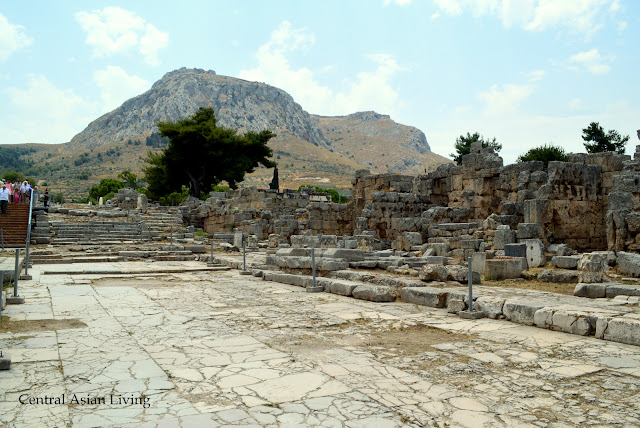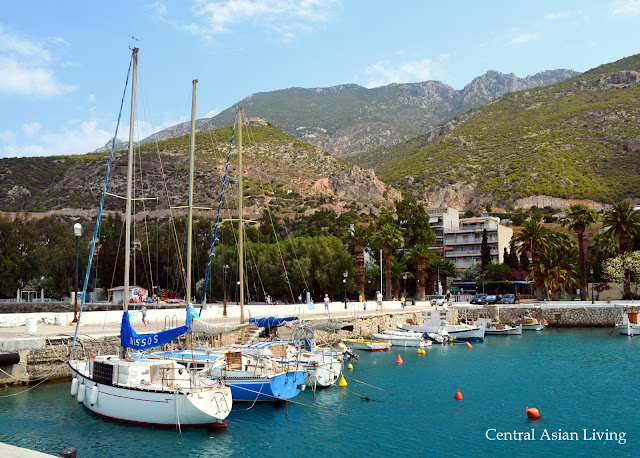Do you remember those moments when time stood still?
 |
| Cesar Augustus |
I find it hard not to pay attention to the clock. (Of course now with mobile phones anyone could, in principle, know what time it is...)
Vacations are different. I stop and when I reach the state when I am not sure if it's Wednesday or Saturday, I call it a success!
We visited a place where time truly has stopped. Ancient Corinth.
The site has a museum with sculptures, busts of Roman rulers, pottery and other findings from the city. The terracotta body parts caused giggles among the kids. Yes, I guess people found it important to make sculptures of those parts, as offerings to Asklepios, god of medicine! (The museum building also has toilets, which is important to know if you go there with kids, air conditioning and the tap water is drinkable!)
This mosaic was part of a floor in a rich Roman house:

I love the details carved in stone. I wonder how much time this piece took? And what kind of tools did they use?
The temple of Octavia, built in honor of Octavia, sister of Emperor Augustus and wife to Mark Antony, possibly after her visit to the city of Corinth. It represents the imperial cult of Rome. All that remains from the temple are three ornate Corinthian columns. On top of them lies a restored architrave.
Ancient Corinth has been a busy place since 6500 BC. Yes, I know, it's ancient :) Most of the surviving buildings are Roman rather than Greek.
 |
| Temple of Apollo |
Eppu did well at the site. He could run and climb and it kept him happy. Sun was out and we got there mid morning, so it was hot. We used the trees for shade every now and then. Hats or umbrellas are a good idea!
The city has been destroyed and rebuild many times. For example Julius Caesar refounded the city as Colonia Laus Iulia Corinthiensis (‘colony of Corinth in honour of Julius’) in 44 BC, shortly before his assassination.
Apostle Paul visited Corinth between 51 and 53 AC and he wrote letters to the church there. The verse above is from the second letter. The rock stands on top of the Bema, a public platform, where at a public hearing, Paul had to defend himself against accusations from the city’s Hebrews that his preaching undermined the Mosiac Law. The pro-consul Lucius Julius Gallio judged that Paul had not broken any Roman Law and so was permitted to continue his teachings.
Corinth became the centre of early Christianity in Greece. Paul became acquainted with Aquila and Priscilla, who became his fellow-workers. He stayed in Corinth for 1,5 years.
The city was destroyed during the Greek War of Independence, 1821–1830.
In 1858, the village surrounding the ruins of Ancient Corinth was totally destroyed by an earthquake, leading to the establishment of New Corinth 3 km NE of the ancient city.
There is still a village surrounding the Ancient ruins. We drove here and there on narrow roads, trying to find our way to the site. Somehow the Google maps didn't quite find the most commonly used road, so we took the road less traveled!
Here you can see the village, the church and a covered corner restaurant which overlooks right into the site:
The majority of the other surviving buildings also include a large forum, baths, the Asklepeion temple to Asclepius, and a centre of healing, fountains - including the monumental Peirine fountain complex (2nd century CE) - a propylaea, theatre, odeion, gymnasium, and stoas. There are also the remains of three basilicas.
Here is the baths:
I am amazed that the road is still there...Smooth and totally usable, even with cracks.
On top of that hill is a fortress that is worth visiting, we heard. However, our "half a day of sightseeing" was running its course and we had to get back for some water time!
I have to mention that there are several cafeterias, markets and souvenir shops right next to the area. I bought a little kitty cat, as it is my tradition to buy a cat sculpture from every country we visit.
Visiting this kinds of places has been great for the kids and homeschooling. They have been studying ancient Greek history, so seeing the actual places has made the lessons come alive for them.

























